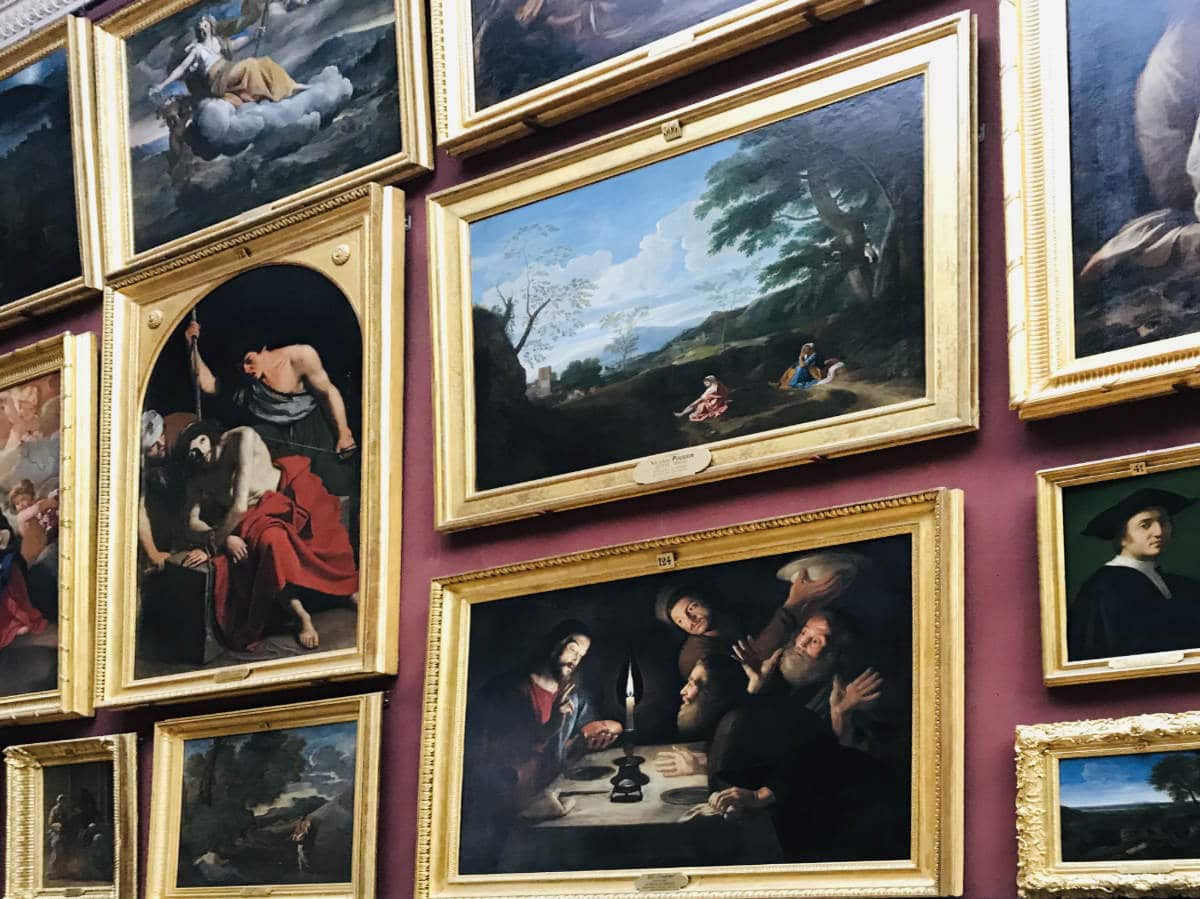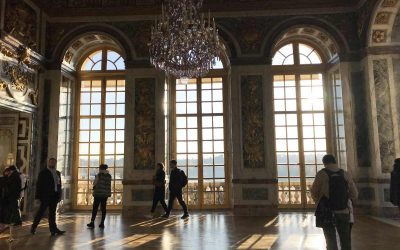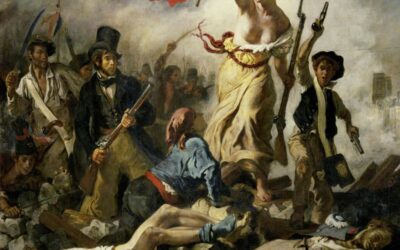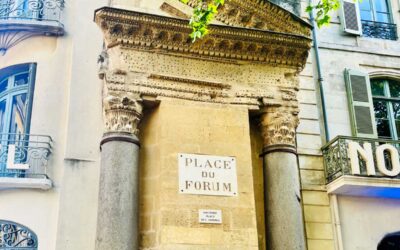France has long been known as the “land of art”, with producing many a famous artist. From the Middle Ages to Renaissance times, Impressionism to post-impressionistic modern art, many of these famous French paintings are still inspiring a new generation of art lovers.
Admired all over, French artists have produced works that are displayed in the finest museums in Paris and around the world, and fetched eye-watering prices at auction. While the Mona Lisa may be Italian, these paintings represent France more than others, capturing the culture of the country as no outsider can.
Take a trip through art history with the world’s most famous French paintings, from Monet’s Water Lilies to Edouard Manet’s Le déjeuner sur l’herbe. Allons-y!
- 1. Eugène Delacroix’s Liberty Leading the People (1830)
- 2. Claude Monet's Water lilies (between 1915 – 1926)
- 3. Jacques-Louis David's The Coronation of Napoleon (1807)
- 4. Auguste Renoir's Bal du Moulin de la Galette (1876)
- 5. Jacques-Louis David's Death of Marat (1793)
- 6. Edouard Manet's Le déjeuner sur l'herbe (1893)
- 7. Edgar Degas's The Absinthe Drinker (1876)
- 8. Claude Monet's La rue Montorgueil à Paris (1878)
- 9. Self Portrait by Van Gogh (1889)
- 10. Gustave Courbet's L'Origine du Monde (1866)
- 11. Marie-Guillemine Benoist' Portrait of a Black Woman (1800)
- 12. Hyacinthe Rigaud's Louis XIV of France (1701)
- 13. Olympia by Édouard Manet (1863)
- 14. Georges Seurat's Sunday Afternoon on the island of La Grande-Jatte (1884 – 1886)
- 15. Theodore Gericault's The Raft of the Medusa (1819)
- 16. Vincent Van Gogh's Bedroom in Arles (1888)
- 17. Paul Cezanne's Card Players (1895)
1. Eugène Delacroix’s Liberty Leading the People (1830)
One of the most emblematic paintings in France is Eugène Delacroix’s Liberty Leading the People. On display at the Louvre Museum, it shows a partially clothed Marianne, the symbol of France, leading the people towards a revolution.

The revolution in question however, is not the 1789 French Revolution, but the the July Revolution of 1830. (Yes, French people like to protest a lot.)
2. Claude Monet’s Water lilies (between 1915 – 1926)
One of the most famous French artists has to be Claude Monet and his work at the forefront of the impressionist movement.
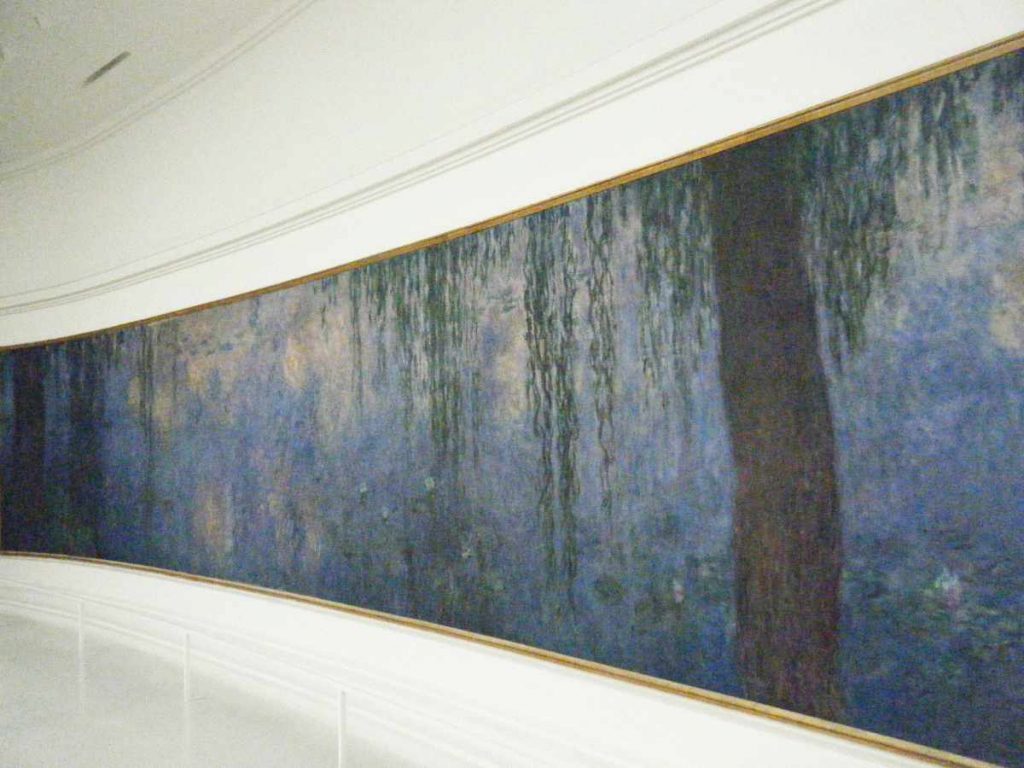
Born in Paris, Monet started off painting everything from landscapes and seascapes to portraits.
He became famous for his waterlilies, which were inspired by his gardens in the village of Giverny, and would paint the same outdoor scenes over and over again in different lighting and seasonal conditions.
You can find several of his artworks at Musée d’Orsay and Musée de l’Orangerie in Paris.
3. Jacques-Louis David’s The Coronation of Napoleon (1807)
One of the largest paintings in the Louvre Museum is the Consecration of Emperor Napoleon Bonaparte and the Coronation of his wife Joséphine as Empress at Notre Dame de Paris.
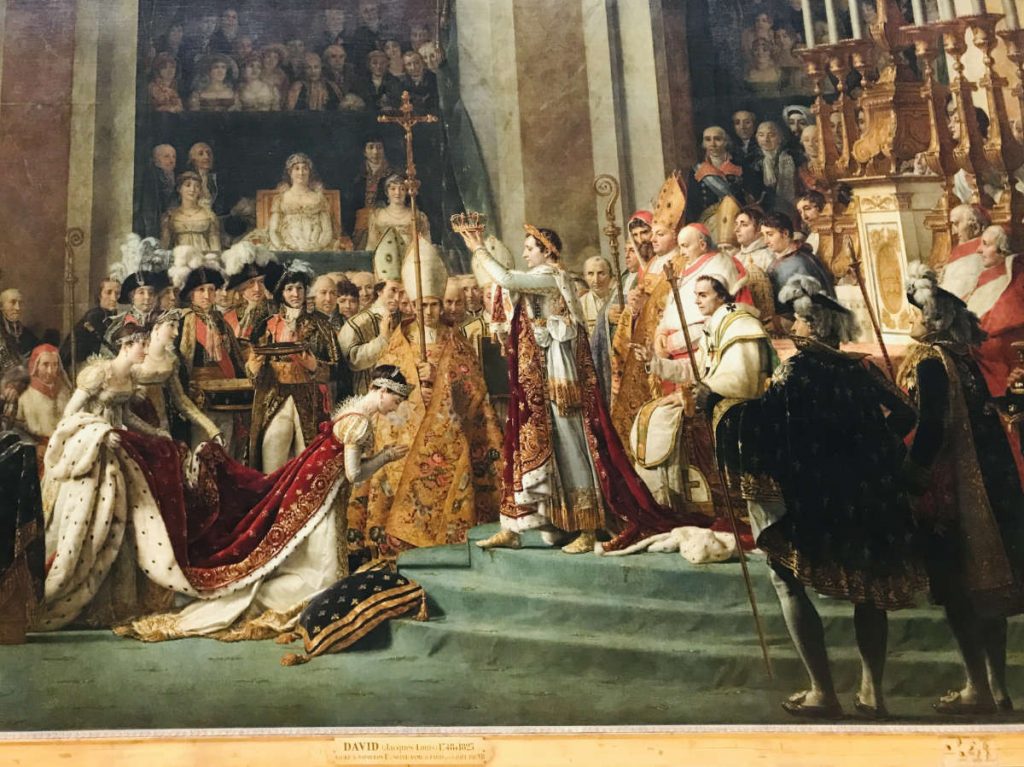
Completed in 1807 by Jacques-Louis David, his official artist, it depicts the coronation of Napoleon at Notre-Dame de Paris, after Napoleon declared himself Emperor.
A copy of the painting by the same artist hangs in the Palace of Versailles. There are a few “creative liberties” that have been taken by Napoleon and his painter, most notably the addition of his mother, who is sitting on a throne in the center watching.
His mother hated his wife Josephine and so actually refused to attend, but Napoleon asked for her to be painted into the tableau anyway.
4. Auguste Renoir’s Bal du Moulin de la Galette (1876)
The “Dance at Le moulin de la Galette” is a painting from 1876 by the famed Pierre-Auguste Renoir.
It is one of Impressionism’s most celebrated masterpieces and a smaller version of this painting which is in private hands, was sold for $78 million in 1990. One can only imagine what price this larger painting would fetch on the open market.
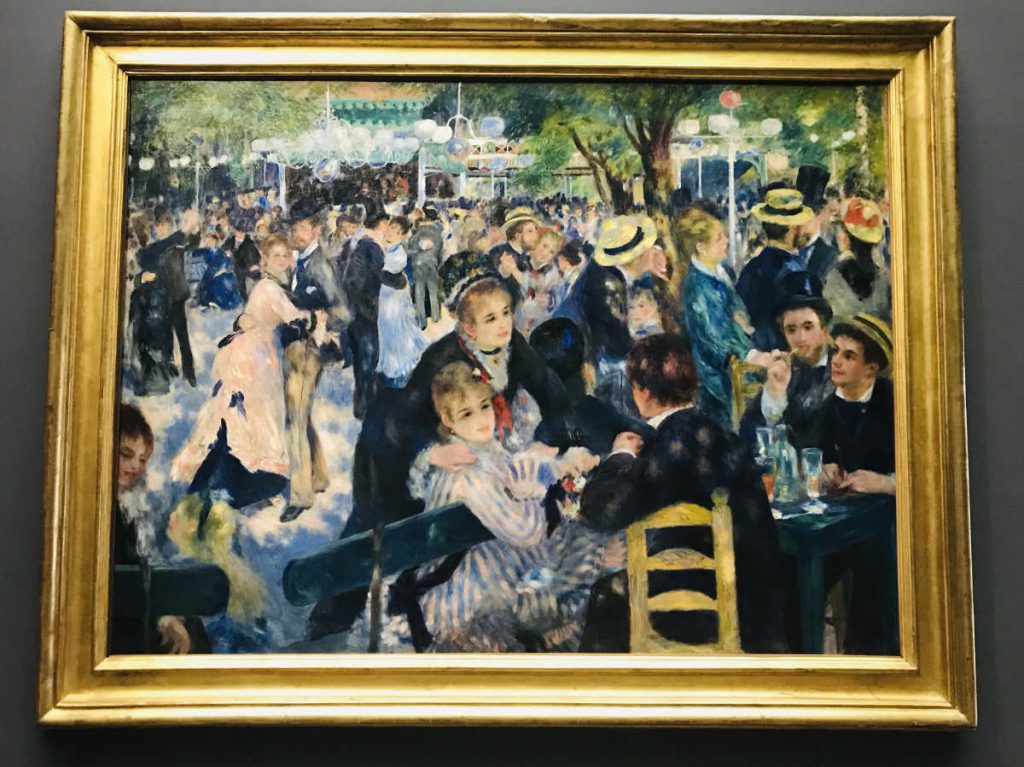
The painting depicts a typical Sunday afternoon at the original Moulin de la Galette in the district of Montmartre in Paris.
It is basically an outdoor bal or party, where Parisians would dress up with friends, dancing and drinking late into the evening. (You can still find bals populaires in Paris which locals flock to, especially on Bastille day.)
5. Jacques-Louis David’s Death of Marat (1793)
Before Jacques-Louis David became Napoleon’s official painter, he was an ardent revolutionary. One of his most famous paintings that epitomizes the 1789 French revolution is La Mort de Marat.
Jean-Paul Marat was a journalist and radical politician during the revolution, and a vigorous defender of the sans-culottes (literally means “without underwear”, but refers to the poorest members of society who couldn’t afford “silk breeches”).
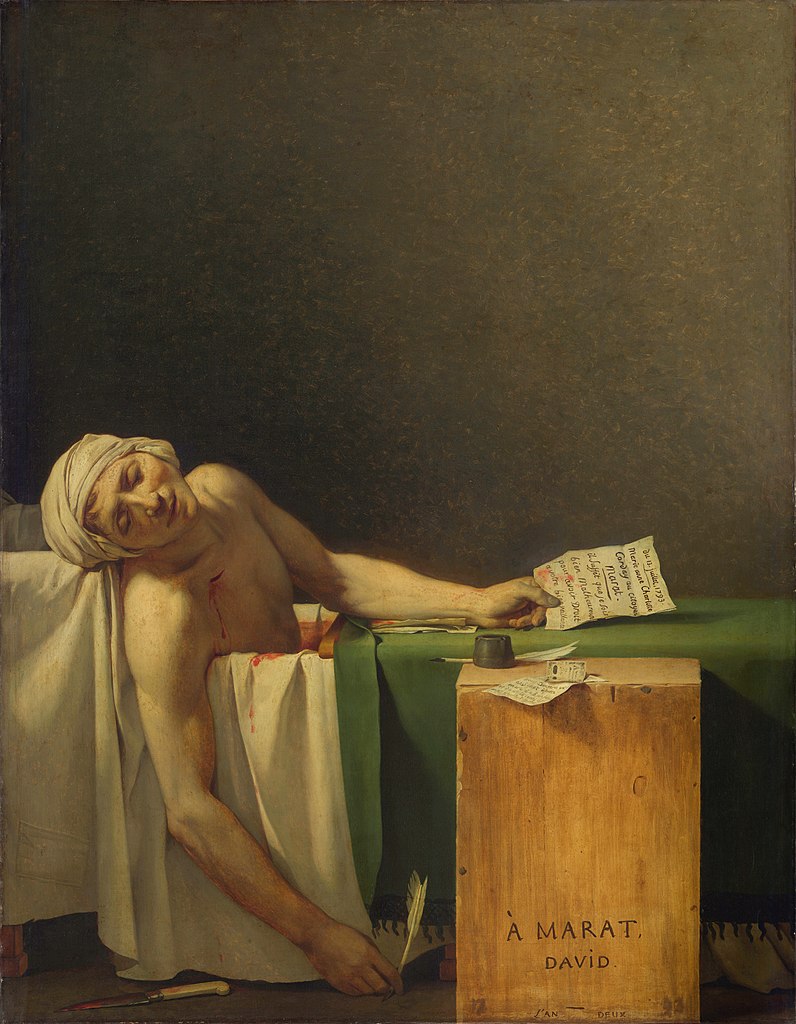
Known for advocating some of the worst massacres during the Reign of Terror through his newspaper, he was already an icon because of his debilitating skin condition that required him to spend much of his day in a medicinal bath.
A member of an opposing revolutionary group, a female activist named Charlotte Corday would purchase a knife at one of the shops of the Palais Royal, and sneak into his bathroom. While he was in the bath, she stabbed him, turning him into a martyr of the revolution.
Jacques-Louis David captures this moment with this haunting painting that is today displayed at Royal Museums of Fine Arts of Belgium.
6. Edouard Manet’s Le déjeuner sur l’herbe (1893)
Painted in 1893, the “Luncheon on the Grass” by Edouard Manet is a large scale painting that measures 81.9 inches x 104 inches.
It depicts a nude female woman, sitting casually at a picnic with an assortment of food next to her, along with two fully dressed men. She is looking straight at the viewer while the two men seem to be in full discussion, ignoring her.
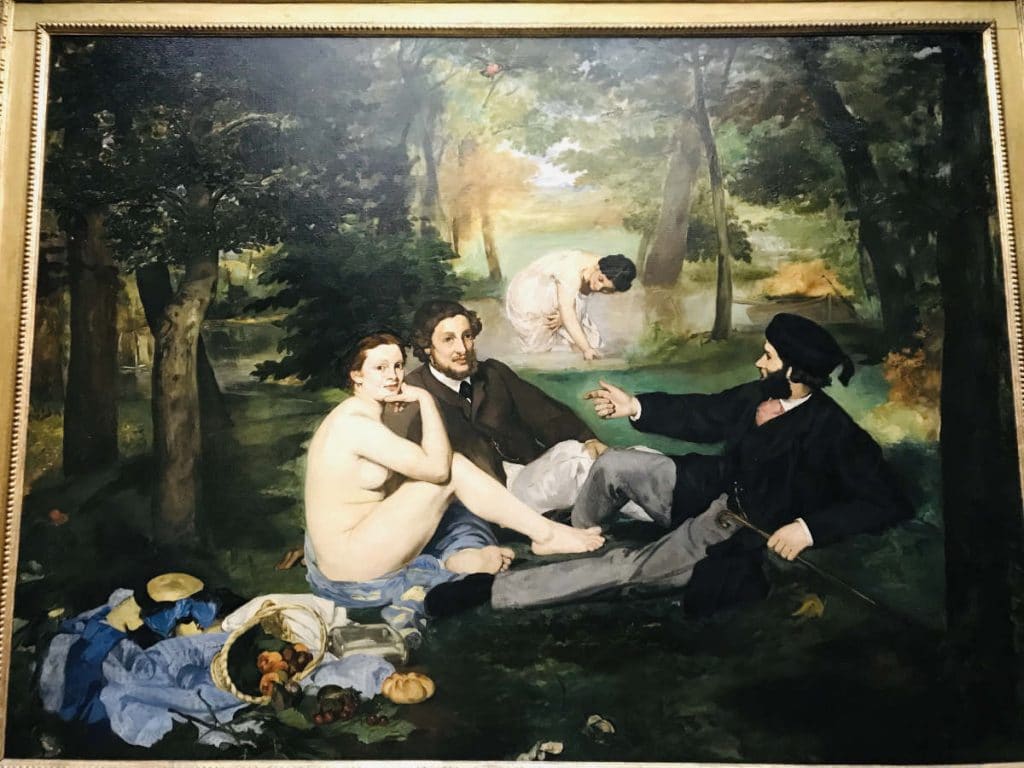
Edouard Manet was already a prominent figure in France when the painting was put on display, and this there were many negative reviews when it was first displayed. Even famous writer and philosopher Emile Zola commented on the “obscene intent” of the juxtaposition of this woman painted in white, while the men are in dark colors.
Inspired by this painting, many other famous contemporaries of Manet like Paul Cezanne, Claude Monet, James Tissot, Paul Gaugin and Pablo Picasso produced paintings of picnics with various levels of nudity.
7. Edgar Degas’s The Absinthe Drinker (1876)
Sometimes called “In a café”, Edgar Degas’s painting shows a man and a woman sitting side-by-side in silent isolation.

Each looks empty and desolate, with the woman perhaps on the verge of tears, and the man looking anywhere else but at her.
The painting referred to absinthe because it was seen as a denunciation of the dangers of that rather harmful liquor which was later prohibited. Today, the painting is on display at Musée d’Orsay in Paris.
8. Claude Monet’s La rue Montorgueil à Paris (1878)
If you wander around central Paris today, you are bound to fall in love with the Rue Montorgueil in the 1st arrondissement. It is a lively pedestrianized road with plenty of small shops and cafés lining both sides of the street.
And it is clear that it made French artist Claude Monet fall in love with it as well.
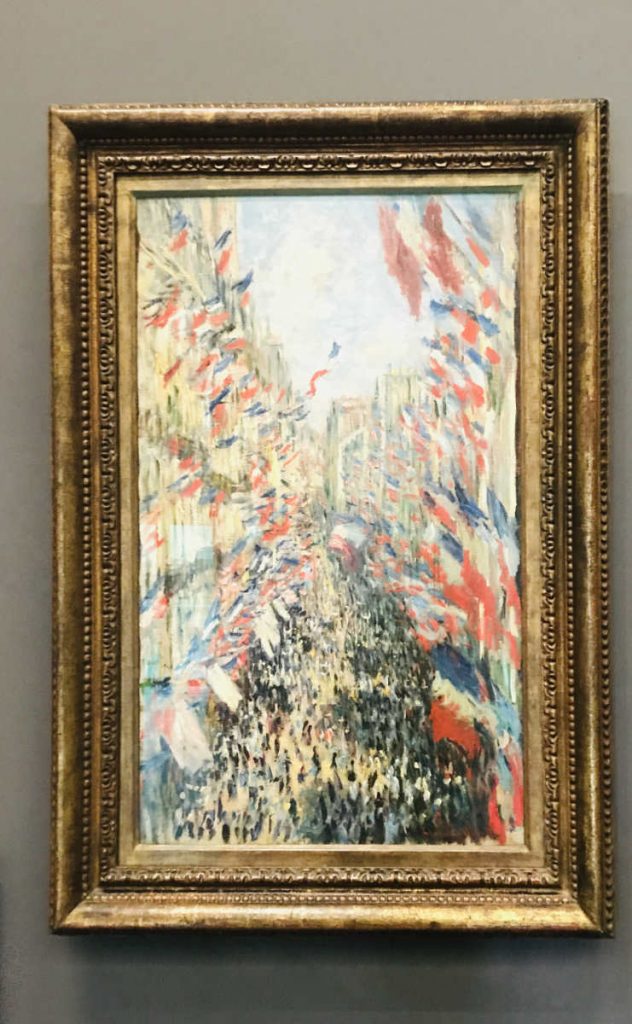
Painted in 1878, the waving French flags are not celebrating Bastille day. Rather it marks June 30 1878, on the occasion of the national holiday for “peace and work”.
This was a new holiday at the time, promoted by the French republican state after the humiliation of the defeat during the Franco-Prussian war by Germany in 1870.
9. Self Portrait by Van Gogh (1889)
Vincent van Gogh’s self-portrait is believed to have been painted in 1889 in Arles or St. Remy de Provence where he spent a couple of years in a mental institution after cutting off his own ear.
Dutch painter Vincent van Gogh spent much of his life in France, specifically in Provence, and around Paris where his brother Theo lived with his family.
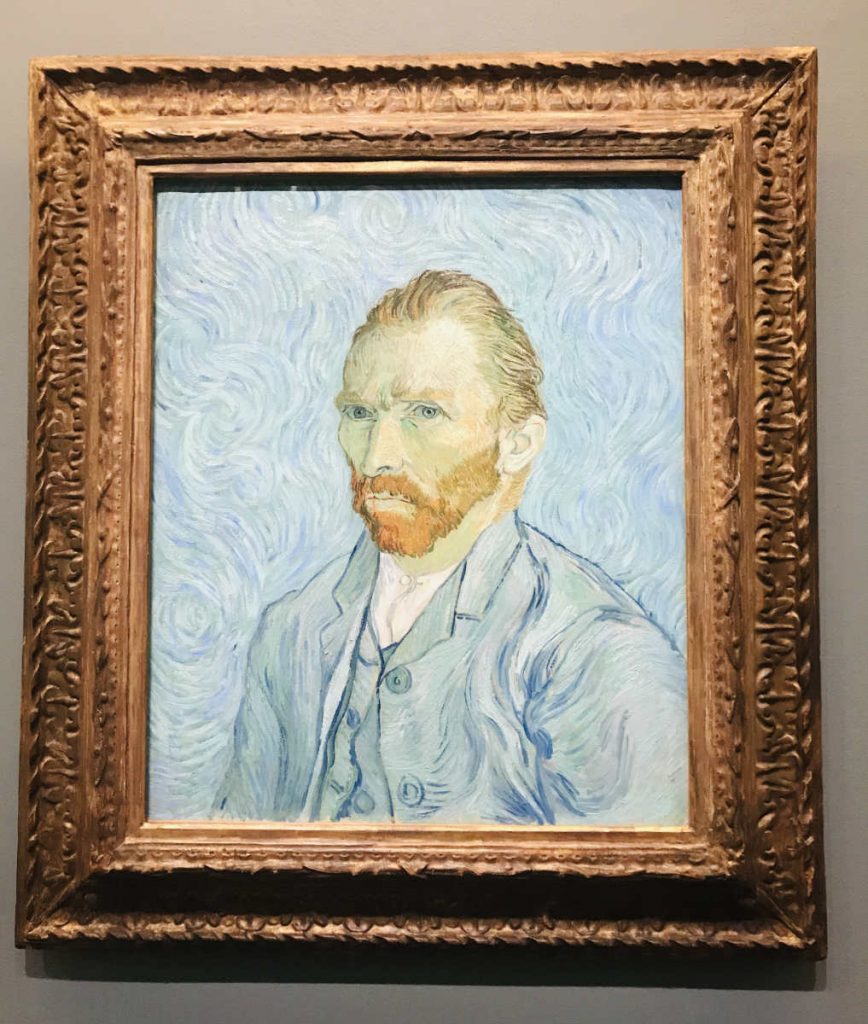
Even in his own self-portrait, his features are slightly anxious and stressed.
Van Gogh was known to indulge in absinthe, and the colors of the painting are a mix of absinth green and pale turquoise, offset by the strong orange beard.
10. Gustave Courbet’s L’Origine du Monde (1866)
The Origin of the World is a painting that has remained controversial ever since it was created in 1866. Painted by French artist Gustave Courbet, it is a close-up view of the nether region of a naked woman, lying on a bed with legs spread.
Unlike other paintings where the nudity is almost sterile and hairless, the graphic nature of this painting is always going to provoke a reaction. Since the painting is definitely rated NC-17, I have not included a photo of the painting but you can find one here.
11. Marie-Guillemine Benoist’ Portrait of a Black Woman (1800)
Marie-Guillemine Benoist was one of France’s top female neoclassical and historical painters who began her training under two other famous French painters, Élisabeth Vigée Le Brun and Jacques-Louis David.
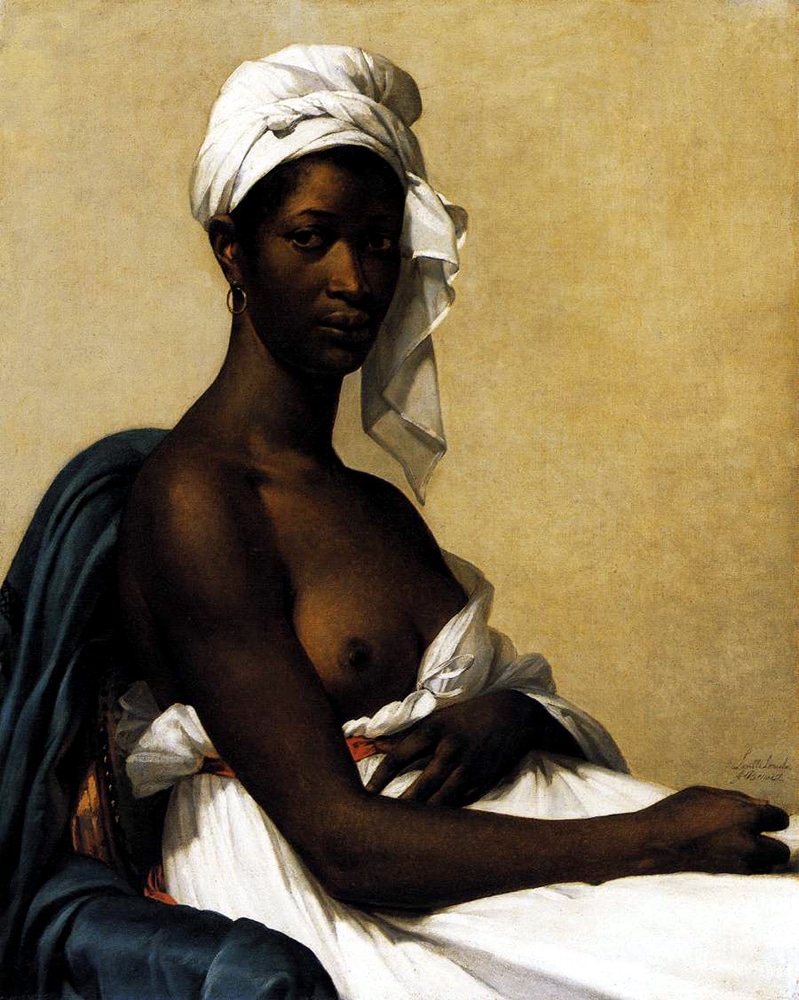
While she painted many important works, one of her most famous is this portrait of an emancipated slave which was painted 6 years after the abolition of slavery.
It became a symbol for the emancipation of women and black people, and today hangs in the Louvre.
12. Hyacinthe Rigaud’s Louis XIV of France (1701)
Born in Perpignan, Hyacinthe Rigaud was a Catalan-French baroque painter most famous for his portraits of Louis XIV and other members of the French nobility.
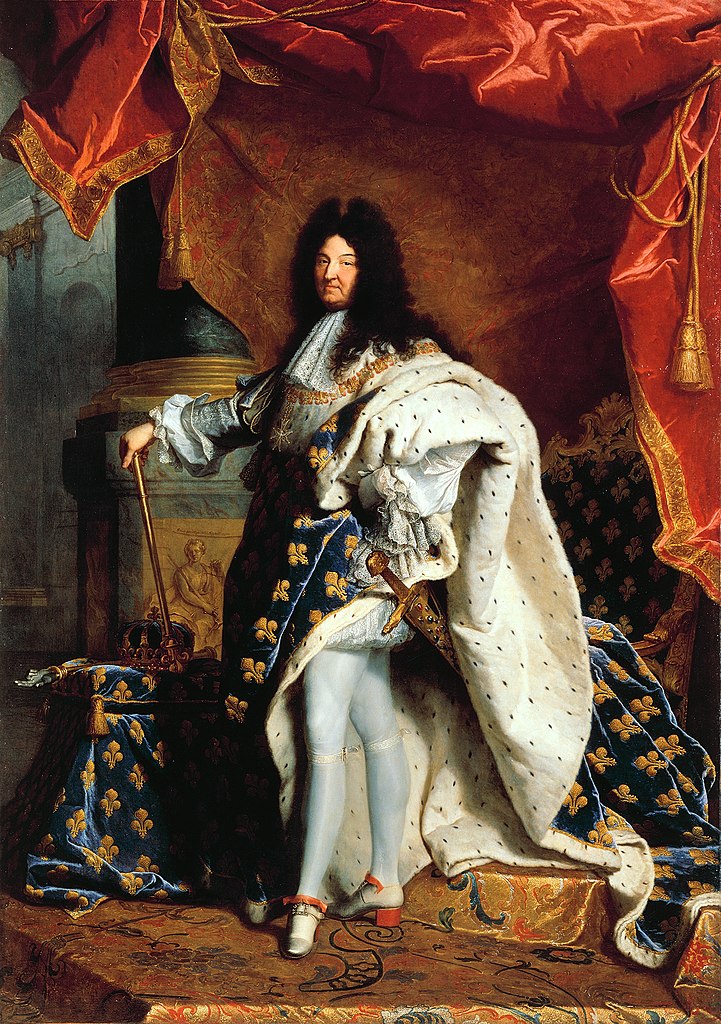
Although Sun King Louis XIV ascended to the French throne when he was 4 years old, this particular painting dates to him being around 63 years old. It was Louis XIV who would build the Château de Versailles.
The Sun King Louis XIV ruled for over 72 years and is the longest recorded of any monarch of a sovereign country in European history. It would cement his place as one of the most well-known French monarchs, and Hyacinthe Rigaud’s portrait as being evocative painting of this time.
13. Olympia by Édouard Manet (1863)
Painted in 1863 by Édouard Manet, Olympia shows a nude woman reclining on a bed, with a fully-dressed black servant attending to her.
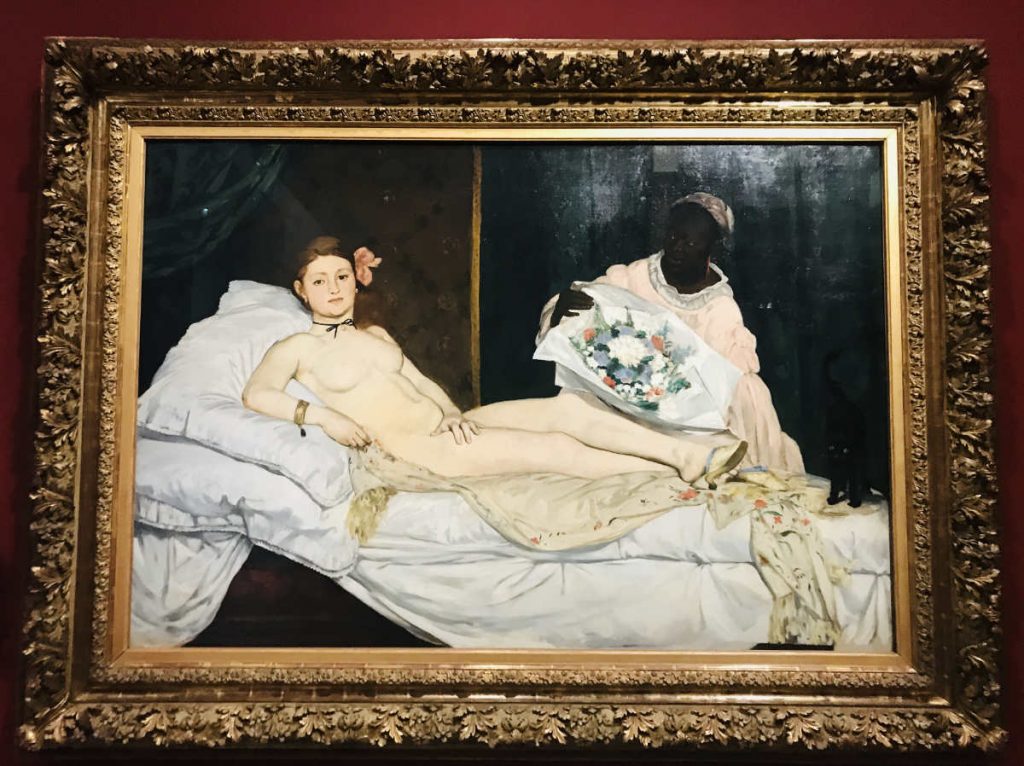
It was shocking even when it was first displayed, although not for the dichotomy of the two figures, but for the straight-forward gaze of the nude woman.
This confrontational look came with the assumption that the woman was a courtesan, as only they would allow themselves to be painted that way. In addition, “Olympia” was a name associated with escorts in 1860s Paris.
More recently, it is the representation of the black woman that has been questioned, including why she has been painted almost disappearing into the background.
For context, the painting “Olympia” was created 15 years after slavery had finally been abolished in France and its empire, but negative stereotypes persisted.
14. Georges Seurat’s Sunday Afternoon on the island of La Grande-Jatte (1884 – 1886)
French post-Impressionist artist is best known for his use of pointillism, making small, almost scientifically uniform dots, to complete his paintings.

This large oil painting is around 81.7 in × 121.25 in (207.6 cm × 308 cm) in size and hangs at the Art Institute in Chicago.
The painting shows a group of aristocrats in a park on Ile de Jatte, a large island in Neuilly-sur-Seine, which is a suburb of Paris. The river is the River Seine.
Known as the richest commune in France, Neuilly-sur-Seine is where the French bourgeoisie live, as is apparent in Seurat’s painting.
15. Theodore Gericault’s The Raft of the Medusa (1819)
French Romantic artist Theodore Gericault was completed when he was merely 27. Measuring 16 ft 1 in × 23 ft 6 in, it depicts a real life moment as the artist imagined it.
In 1816, the French naval frigate Méduse ran aground off the coast of what is today called Mauritania, on its way to Senegal.

Although it was carrying over 400 people on board, only which 151 managed to make it to a raft.
Many were washed into the sea by a storm, others were killed or took their own lives. The injured were thrown into the sea and survivors engaged in cannibalism when supplies ran low and After 13 days on sea, the rescue boats found the raft with only 15 men surviving.
The incredible shock of the event made headlines all over France. The painting by Theodore Gericault today hangs in the Louvre.
16. Vincent Van Gogh’s Bedroom in Arles (1888)
Another one of Van Gogh’s most famous artworks is the painting of his small bachelor bedroom in Arles, in Provence.
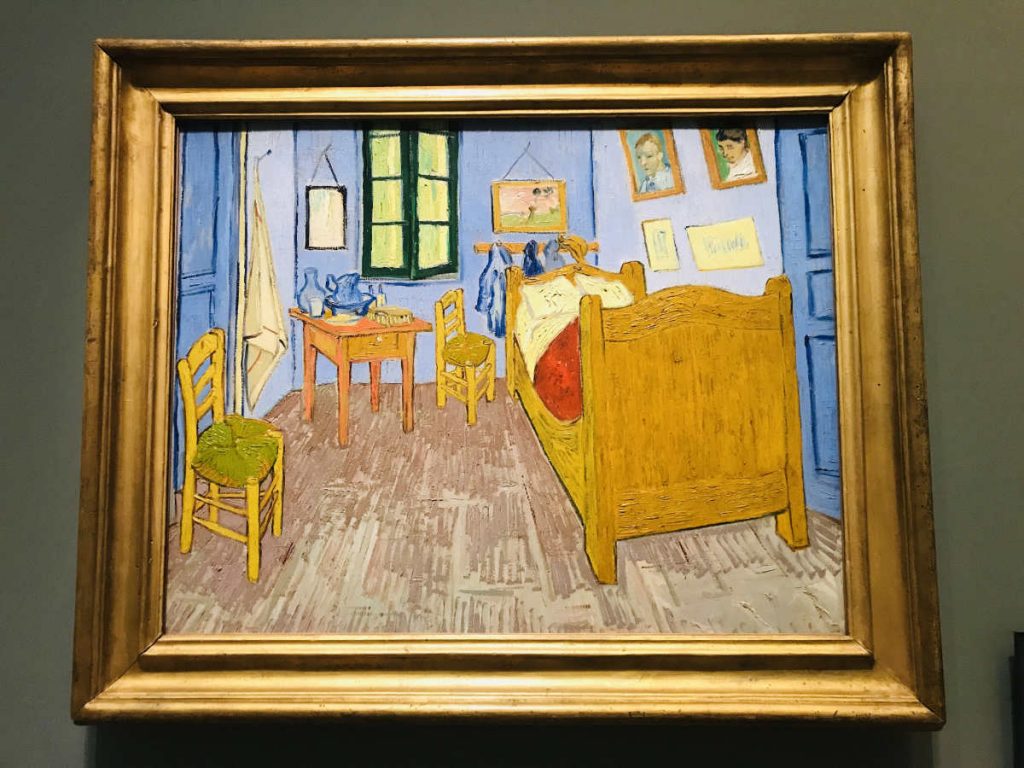
It was painted in 1888 and is based on his room at the Yellow House at Place Lamartine in Arles.
Van Gogh created at least 3 versions of this painting with one version at the Van Gogh Museum in Amsterdam and another one in the Art Institute of Chicago. The one at the Musée d’Orsay is the 3rd one painted.
17. Paul Cezanne’s Card Players (1895)
French artist and Post-Impressionist painter is known for using repetitive, small brushstrokes that build up to form complex fields. Some of his most famous paintings are his series of paintings about Card Players.

One of the 5 paintings in the The Card Players Series was sold in 2011 to the Royal Family of Qatar for a price estimated at $250 million.
This version of Cezanne’s Card Players currently hangs in Musée d’Orsay and depicts Provençal peasants smoking pipes and playing cards.

If you enjoyed that article, you may like to read more about famous French artists as well as the best of French culture. A bientôt!
